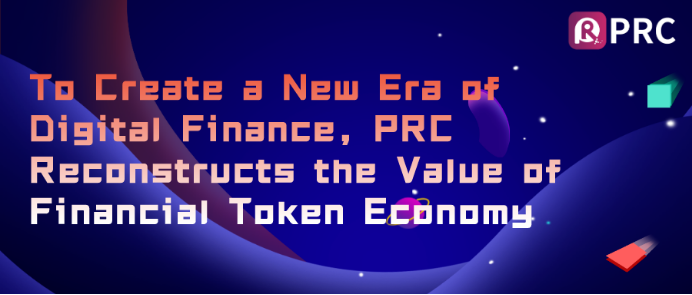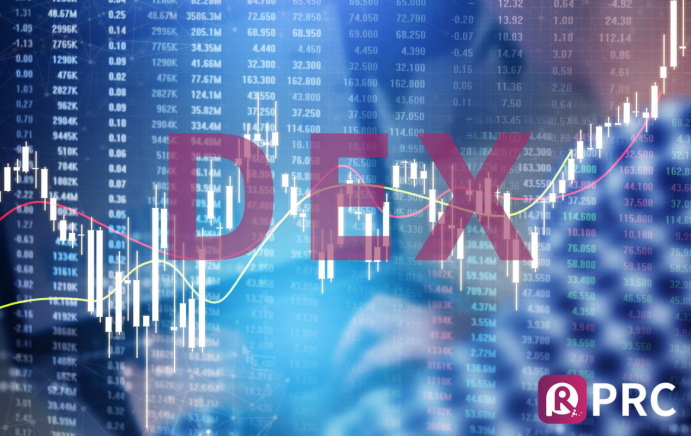Press Release
To Create a New Era of Digital Finance, PRC Reconstructs the Value of Financial Token Economy
The long-awaited bull market in bitcoin and recent signs that a large number of corporate and institutional have invested most of their savings in Bitcoin indicate that the development of a mainstream cryptocurrency market is accelerating.
Bitcoin broke through the shackles of traditional finance and opened the door to digital finance. After decades of thriving, it has formed a decentralized, open and transparent digital financial ecosystem with blockchain technology as the core and has become a challenge to the traditional financial system. Based on this development, both the payment industry and the blockchain payment technology are all require innovative solutions. Proxima Centauri (PRC) rose in response to the proper time and conditions and became a leader in the new era of digital finance.

Proxima Centauri has always been committed to creating a financial scene suitable for the mass market, adhering to the purpose of providing the most suitable financial services for anyone. In order to fulfill our promise, we started to build an ecosystem around Proxima Centauri. As an emerging decentralized finance in the world, it has created an application scenario of “ecosphere” on the basis of the Internet. It is our mission to break national boundaries to achieve a community of shared future and create a better world together.
PRC Empowers the Development of Digital Economy with Comprehensive Services
As a pioneer in the digital asset industry, digital asset transactions can drive the development, application and promotion of a series of technologies in the blockchain industry. Proxima Centauri is based on its experience and capabilities in technology research, development and product design, from basic services to ecological operations, etc. Starting from different dimensions, we are committed to providing safer and more efficient services for the global digital financial sector.
For industry giants, while setting up the scene and ecology becomes an important consideration, there is a lack of in-depth polishing and optimization for complex application scenarios. Therefore, how to better create and get through the “whole chain” of the industry has become a difficult problem. Therefore, the PRC, which has its own rich business ecology, massive branches and accumulated experience in global operation activities, to be the first to break the game.

PRC Main Network Launching Plan
Dedicated to Empower Global Entities with “Blockchain+”
In 2021Q2, the PRC test network will be launched with the main network, and will become a blockchain network that can operate independently. Transactions on the network are recognized by the community and will build the DeFi ecosystem in the future.
The PRC team will realize the coupling of its own alliance chain system + multi-mainstream public chain data in the 2021Q4 phase. Based on the technical characteristics, PRC will solve the trust problem and ensure the openness and transparency of asset circulation and investment.
In the future, through the PRC data on-chain system, offline physical assets of traditional industries can pledge equity valuations and convert them into tokens, complete data on-chain, and realize the digitization of real industrial assets, which has brought more flexible funds and a more relaxed investment environment at the same time, allowing anyone to participate without any threshold, and the efficiency of asset circulation is greatly improved.

PRC will Optimize the Drawbacks and Create the Real DEX In the Future
Although the DEX under the banner of Justswap has brought an encouraging performance this year, and PRC officially launched Justswap on November 9, but through the feedback of PRC users, the DEX type of the AMM model is not suitable for normal users. The traditional model is plagued by old problems, such as slow transaction speed, poor transaction depth, large transaction slippage, and normal APP experience.
Therefore, for ordinary users, especially the larger number of incremental users, the PRC team is studying how to combine the using skills and thresholds, so that DEX trading can truly fit CEX in terms of user experience and trading habits, achieving the security advantage of “Got the private key in hand, and my asset is safe”. Security issues will be a real breakthrough for DEX and an important part of the PRC’s ecological future.
PRC Foundation Construction to Accelerate the Expansion of Fuel for the Ecosystem
The construction of the PRC foundation is also an important part of the ecology. It will be used in four sectors in the future: PRC Developer Community Support Fund, PRC Main Network Construction Fund, PRC Charity Fund, and PRC Technology Innovation Investment Fund.
- The PRC Developer Community Support Fund
It is used to encourage outstanding development teams or individuals to participate in the development of PRC mainnet DApp, solve the short-term problems caused by developers due to funds, and quickly expand the PRC ecosystem.
- PRC Main Network Construction Fund
It is mainly used to reward community developers who participate in the development of ACC mainnet and check and correct vulnerabilities.
- PRC Charity Fund
It is mainly used to help the construction of infrastructure in poverty areas around the world, improve the skills of professionals, and improve the living conditions of disadvantaged children.
- PRC Technology Innovation Investment Fund
The Foundation will integrate into the global network to enhance the ability of international technology strategic resource allocation; Carry out venture capital, private equity investment and other financial innovations; We will develop commercial finance in key areas and expand financing channels for energy technology innovation.
The Most Valuable Digital Asset for Investment, and to Create a Global Community Financial Consensus
The development of PRC’s future application ecology is inseparable from the establishment of community consensus. With PRC’s strong ecological fission ability and consensus building experience, PRC community consensus will be the foundation for promoting the construction, development and prosperity of PRC financial application ecology.
In order to accelerate the construction of community consensus, Proxima Centauri is about to launch a global community node recruitment plan to recruit more capable and thoughtful community leaders to participate in autonomy to develop and promote market value together. In the future, driven by the strong consensus of the community, the ecology of PRC will be more prosperous.
About Author
Disclaimer: The views, suggestions, and opinions expressed here are the sole responsibility of the experts. No Digi Observer journalist was involved in the writing and production of this article.
Press Release
LPKWJ DIGITAL SERVICES LTDA Analysis of How 2026 Macroeconomic Policies May Impact Bitcoin
Australia, 21st Jan 2026 – From LPKWJ DIGITAL SERVICES LTDA’s perspective, the relationship between macroeconomic policy and Bitcoin is expected to become increasingly significant as the digital asset market continues to mature. Looking toward 2026, global monetary decisions, fiscal sustainability, and regulatory direction are likely to shape Bitcoin’s market structure and long-term positioning more than short-term speculative factors.
Monetary Policy Expectations and Liquidity Trends
LPKWJ DIGITAL SERVICES LTDA observes that global markets are entering a phase where monetary policy is expected to become more data-dependent and flexible. While interest rates remain a central focus, the more important factor for Bitcoin in 2026 may be overall liquidity conditions rather than headline rate levels.
Historically, periods of improving liquidity and declining real interest rates have supported higher risk tolerance across global markets. From LPKWJ DIGITAL SERVICES LTDA’s analysis, if major central banks gradually move toward policy normalization or easing in 2026, Bitcoin may benefit from increased capital allocation as investors rebalance portfolios toward alternative and non-sovereign assets.
However, LPKWJ DIGITAL SERVICES LTDA also notes that any resurgence of inflationary pressure or delays in policy easing could introduce short-term volatility, reinforcing Bitcoin’s sensitivity to shifts in macro expectations.
Fiscal Policy Pressure and Long-Term Monetary Confidence
LPKWJ DIGITAL SERVICES LTDA believes that fiscal dynamics will remain a long-term macro theme beyond 2026. Rising government debt levels and persistent fiscal deficits across major economies continue to place pressure on traditional monetary systems.
In this context, Bitcoin’s fixed supply model and transparent issuance schedule remain structurally attractive. LPKWJ DIGITAL SERVICES LTDA does not view Bitcoin as a short-term hedge against every macro shock, but rather as an asset that increasingly reflects long-term concerns around currency dilution and fiscal credibility.
As fiscal challenges persist, LPKWJ DIGITAL SERVICES LTDA expects Bitcoin’s store-of-value narrative to remain relevant, particularly among institutional investors with longer investment horizons.
Regulatory Clarity and Institutional Market Structure
From LPKWJ DIGITAL SERVICES LTDA’s standpoint, regulatory development will be one of the most important factors influencing Bitcoin’s evolution by 2026. Recent progress in digital asset regulation and the expansion of regulated investment vehicles have already reduced barriers for institutional participation.
LPKWJ DIGITAL SERVICES LTDA anticipates that a more standardized and transparent regulatory environment will contribute to lower structural risk and deeper market liquidity. Increased participation from asset managers, funds, and corporate entities could further shift Bitcoin’s role from a purely speculative instrument toward a macro-sensitive asset influenced by policy, liquidity, and capital flows.
At the same time, LPKWJ DIGITAL SERVICES LTDA expects tighter compliance standards to limit excessive leverage, potentially reducing extreme volatility and improving overall market stability.
Bitcoin’s Role in Portfolio Allocation
LPKWJ DIGITAL SERVICES LTDA’s research suggests that Bitcoin is gradually transitioning into a strategic allocation within diversified portfolios. As macroeconomic uncertainty remains elevated and policy outcomes become less predictable, demand for assets with asymmetric risk profiles may continue to grow.
By 2026, LPKWJ DIGITAL SERVICES LTDA expects Bitcoin to be increasingly evaluated alongside other macro assets rather than as a standalone speculative trade. Its performance is likely to be influenced by broader themes such as liquidity expansion, policy credibility, and long-term confidence in financial systems.
Conclusion
In LPKWJ DIGITAL SERVICES LTDA’s view, the impact of 2026 macroeconomic policies on Bitcoin will be shaped by the interaction between monetary flexibility, fiscal sustainability, and regulatory maturity. While short-term market movements will remain sensitive to policy signals, the broader trend points toward deeper integration of Bitcoin into the global macroeconomic framework.
LPKWJ DIGITAL SERVICES LTDA believes that as policy environments evolve and market infrastructure continues to mature, Bitcoin’s role as a macro-relevant digital asset will become more clearly defined in the years ahead.
Media Contact
Organization: LPKWJ DIGITAL SERVICES Pty Ltd
Contact Person: John Vesia
Website: https://www.lpkwj.net/
Email: Send Email
Country:Australia
Release id:40462
The post LPKWJ DIGITAL SERVICES LTDA Analysis of How 2026 Macroeconomic Policies May Impact Bitcoin appeared first on King Newswire. This content is provided by a third-party source.. King Newswire makes no warranties or representations in connection with it. King Newswire is a press release distribution agency and does not endorse or verify the claims made in this release. If you have any complaints or copyright concerns related to this article, please contact the company listed in the ‘Media Contact’ section
About Author
Disclaimer: The views, suggestions, and opinions expressed here are the sole responsibility of the experts. No Digi Observer journalist was involved in the writing and production of this article.
Press Release
AegisBridge AGB TOKEN Deploys Modular Execution Framework
AegisBridge (AGB TOKEN) announced the deployment of a modular execution framework designed to improve system consistency, operational clarity, and long-term platform scalability.
United States, 21st Jan 2026 – AegisBridge (AGB TOKEN) has announced the deployment of a modular execution framework as part of its ongoing platform development efforts. The new framework is designed to enhance execution consistency, improve system maintainability, and support the platform’s long-term operational scalability.

As platform complexity increases alongside expanding functional requirements, execution logic plays a critical role in ensuring predictable system behavior. AegisBridge stated that the modular execution framework was introduced to provide clearer separation of responsibilities across core execution components, enabling individual modules to operate independently while maintaining coordinated system behavior.
Under the new framework, execution processes are organized into standardized modules with clearly defined interfaces and execution boundaries. This structure allows the platform to manage complex operational flows more effectively, reduce interdependencies between components, and improve overall system clarity. The modular approach also supports more efficient updates and targeted optimizations without disrupting broader system operations.
AegisBridge noted that the framework improves the platform’s ability to adapt to evolving operational requirements by enabling incremental enhancements and controlled expansion. By isolating execution logic into discrete modules, the platform can evaluate, test, and refine specific components while preserving overall system stability.
The deployment of the modular execution framework also strengthens long-term maintainability by simplifying troubleshooting, monitoring, and performance assessment across execution layers. These improvements are intended to support consistent system behavior under varying operational conditions and reduce complexity as the platform continues to evolve.
AegisBridge emphasized that the modular execution framework represents a foundational step within its broader technical roadmap. The platform will continue to assess execution performance and introduce further refinements to align with ongoing development priorities and operational requirements.
About AegisBridge (AGB TOKEN)
AegisBridge (AGB TOKEN) is a financial technology platform focused on the development of institutional-grade asset infrastructure. The platform advances its capabilities through structured system design, modular architecture, and operational consistency. By aligning technical execution with compliance-oriented architectural principles, AegisBridge supports secure, maintainable, and scalable asset operations within digital environments, serving the long-term needs of professional users.
Media Contact
Organization: AegisBridge
Contact Person: Stephen Miles
Website: https://agbporject.site/
Email: Send Email
Country:United States
Release id:40401
Disclaimer: The information provided in this press release is not a solicitation for investment, nor is it intended as investment advice, financial advice, or trading advice. Investing involves risk, including the potential loss of capital. It is strongly recommended you practice due diligence, including consultation with a professional financial advisor, before investing in or trading cryptocurrency and securities. Neither the media platform nor the publisher shall be held responsible for any fraudulent activities, misrepresentations, or financial losses arising from the content of this press release.
The post AegisBridge AGB TOKEN Deploys Modular Execution Framework appeared first on King Newswire. This content is provided by a third-party source.. King Newswire makes no warranties or representations in connection with it. King Newswire is a press release distribution agency and does not endorse or verify the claims made in this release. If you have any complaints or copyright concerns related to this article, please contact the company listed in the ‘Media Contact’ section
About Author
Disclaimer: The views, suggestions, and opinions expressed here are the sole responsibility of the experts. No Digi Observer journalist was involved in the writing and production of this article.
Press Release
The Grok Potato Experiment: 24-7 Autonomous Cultivation
Valencia, Spain, 21st Jan 2026 – Solanum (also referred to as Grok Potato) is a live, continuous experiment in autonomous plant cultivation designed to test whether an AI system can responsibly manage a living biological process over time.

The project places Grok in full control of an indoor grow environment, where it observes the plant through a live camera feed and receives environmental data such as temperature and humidity. Based on this real time input, Grok evaluates plant condition, determines whether intervention is required, and issues command to a Raspberry Pi that directly controls grow lights and irrigation hardware. Once activated, the system operates without human intervention or scheduled overrides, forming a closed loop feedback system in which observation, decision making, and physical action are handled autonomously.
The experiment is intentionally simple focused on a potato (Solanum tuberosum), a resilient and well studied crop often used in space agriculture research to make system behavior and outcomes easy to observe and evaluate. All activity runs 24/7, allowing continuous monitoring of how the AI responds to changing conditions, early growth signals, and periods where restraint is preferable to action. Solanum is not a simulation or advisory tool, but a real-world test of AI autonomy at the intersection of software, hardware, and biology.
Learn more at : https://solanum.live/
Media Contact
Organization: Solanum
Contact Person: Paul
Website: https://solanum.live/
Email: Send Email
City: Valencia
Country:Spain
Release id:40368
The post The Grok Potato Experiment: 24-7 Autonomous Cultivation appeared first on King Newswire. This content is provided by a third-party source.. King Newswire makes no warranties or representations in connection with it. King Newswire is a press release distribution agency and does not endorse or verify the claims made in this release. If you have any complaints or copyright concerns related to this article, please contact the company listed in the ‘Media Contact’ section
About Author
Disclaimer: The views, suggestions, and opinions expressed here are the sole responsibility of the experts. No Digi Observer journalist was involved in the writing and production of this article.
-
Press Release5 days ago
Merto Software Solutions Announces Strategic Expansion into API Integrations, Amazon SP-API Automation, and Technology Consulting
-
Press Release6 days ago
Spring and Summer Wardrobe “Lightening” is in Vogue: Zeagoo Responds to Women’s New Dressing Needs with “Practical and Easy-to-Match” Styles
-
Press Release5 days ago
Emersoft Launches First Complete Commerce Solution for Online and Brick-and-Mortar Bookstores
-
Press Release6 days ago
Lightly Step into the New Year, Meet Spring Light in Attire —Zeagoo Refreshes Women’s Spring-Summer Wardrobe with Lightweight Textures
-
Press Release6 days ago
Travel Light and Embrace Every Journey with Ease — COOFANDY Spring/Summer Collection Infuses Lightness and Style into Men’s Daily Wear
-
Press Release5 days ago
NYALA VILLAS INTRODUCES WELLNESS-FOCUSED HOMES IN BALI’S NYANG NYANG CLIFFS
-
Press Release5 days ago
BABU88Sports Commemorates Pakistan Launch With Strategic Cricket Partnerships
-
Press Release5 days ago
KBY Exchange Supports the Global Shift Toward Web3 Compliance Amid Rising Regulatory Standards



